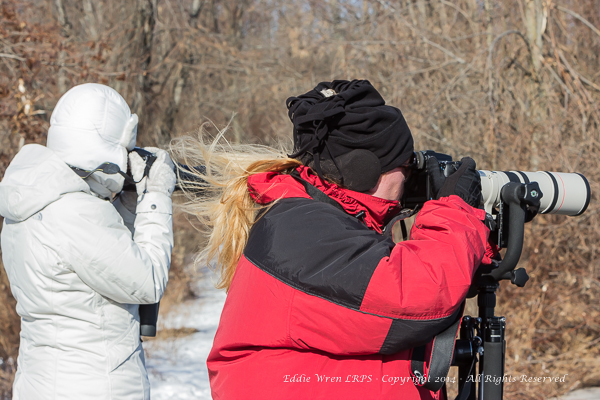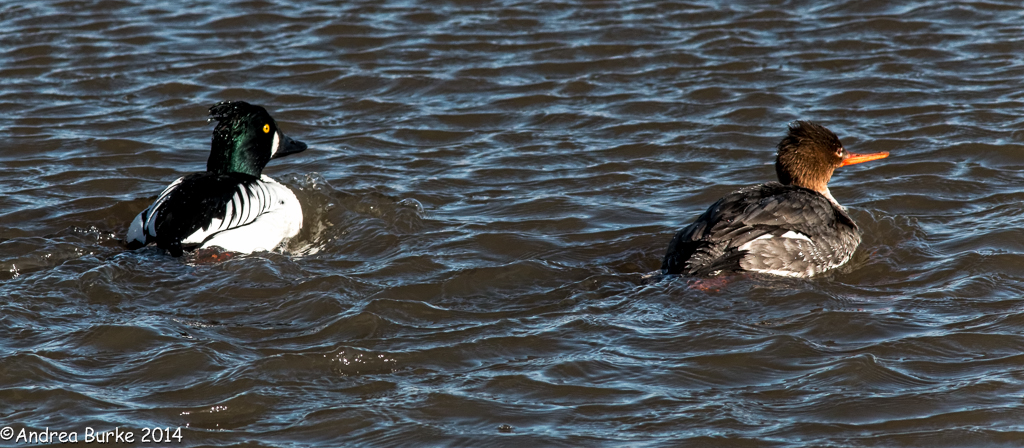About a week ahead of the walk, meteorologists had forecast a realtively balmy 25F for the day of our Buckhorn Island State Park birding trip, but as each day went by, the promised temperature dropped by about a degree until — on the day of the walk — it was a mere 18F…. a little too chilly for some. Even so, a few moderately intrepid individuals were still “up for it,” and we were rewarded with plenty sunshine even though its warmth was completely overcome by the breeze.

Tundra Swans (with a couple of Canada Geese) resting on an island in the Niagara River
New person Donna, plus myself and Andrea were the first to arrive at Woods Creek canoe launch parking lot and we were all promptly caught napping when a small flock of birds was spotted in a nearby tree, stunningly highlighted in gold by the sunshine. I think we must all have been momentarily mesmerised by what can genuinely be called a beautiful moment, to the extent that the cedar waxwings in question all flew away before any of us had the sense to “get the shot!” Yes, “only” cedar waxwings, but you should have seen that light on them!

Donna and Andrea at work
After the short walk through the woods to the river, it took only a few moments to pick out over 40 distant Tundra Swans, huddled down with their heads tucked in, for warmth. A couple of them later lifted their heads and an additional swan flew in, and these two little incidents gave us a somewhat better look (see above).

Male and female Bufflehead
With the vast majority of the waterbirds being well out into the Niagara River, it was inevitably longer lenses that were most useful. However, courtesy of Andrea, I was trying out her Canon EF 70-200mm f/2.8 IS USM zoom lens and I’ve posted a few of the cropped results on this page. (Thanks, Andrea!)

Red-breasted Merganser – male
For any birders not from this area on the US/Canadian border, it is worth adding that the Niagara River is classed as an Important Bird Area [IBA] by both countries. Indeed, in winter, the Niagara River hosts up to 20 percent of the world population of Bonaparte’s Gulls, making it a globally significant IBA.

A male Common Goldeneye and a female Red-breasted Merganser
More information about the Niagara River IBA may be found at http://www.ibacanada.ca%2Fconservationplans%2Fonniagrarivercorridor.pdf

Three male Greater Scaup (Aythya marila) – a.k.a. just ‘Scaup’ in Britain
At the bridge over Woods Creek, right where the creek hits the Niagara, a few Greater Scaup, some Bufflehead and some Red-breasted Mergansers had come in closer to the shore, which made the challenge easier. At this location, many of the photos here could have been taken with a pocket-sized camera (subject to cropping) — something which doesn’t happen as often as one might like.

Two Red-breasted Mergansers — a definite female in the foreground, with an apparent first-winter bird behind.
The bird species I noted during this walk were as follows (but anyone else that can add to the list, please let me know what you saw, and I’ll include them):
- Tundra Swan (>40)
- Canada Goose
- Canvasback
- Greater Scaup
- Common Goldeneye
- Bufflehead
- Common Merganser
- Red-breasted Merganser
- Ring-billed Gull
- Herring Gull
- Greater Black-backed Gull
- Rock Dove
- American Crow
- Black-capped Chickadee
- Cedar Waxwing
- American Tree Sparrow
- Northern Cardinal

Finally, on our way back to the cars, it would appear that neither Andrea nor I could resist being distracted for a few moments by what will hopefully be the last of the winter woodland sights for this year: Andrea by a water- and ice-bound dead tree and myself by one of one of my own favourite winter subjects — red berries!

Just as the warlord in the movie ‘Last of the Samurai’ allegedly spent his life looking for the one perfect cherry blossom, I think I’m equally addicted to red berries! {:-)
As for our Wildlife Watchers and Nature Photographers group, anyone in the WNY or South Ontario areas who might be interested in coming on some of our walks please just e-mail me on wwnp [at] eddiewren [dot] com
From the first of April until Nov/Dec, we will be out somewhere most weekends.
Eddie Wren